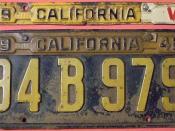"No particular measure changed teen driving behavior, but the combination of a number of them."-The Atlanta Journal
Driving may not exist if it weren't for the laws that contained it. On January 1, 1999, the legislation of Indiana passed a law requiring drivers younger than 18 to hold a probationary driver's license. Under this law all drivers under 18 hold a probationary driver's license and are subjected to certain restrictions and provisions. But is it enough? Or is it too much? The two main reasons, (or goals), of this law were made to enforce safer driving habits among new drivers and to save lives. This new law brought significant improvement, showing it had done its job and no new restrictions needed to be added. Due to the positive effect of the probationary license system, new restrictions and laws were not needed.
Throughout the United States, goals of safer driving habits and saving lives has taken great effect.
Safe drives, save lives, and keep good order. The statement by Indiana's BMV Commissioner Gary A. Gibson backed this reason up by saying, "We believe that probationary driver's licensing as proposed by the General Assembly will save lives." The country and state of Indiana have clearly met this goal. All around the country there have been drops in teen crashes ranging from 5 to 16 percent. Younger drivers are practicing driving with more discernment and care. Teens are now working cooperatively with the present restrictions and are showing a potential to make an even greater decrease in accidents. With the present "probationary" or "graduated" licenses, they have three levels of driving restraints that experience the new driver to different scenarios at a time. By the time they turn 18 they have the experience needed to drive safely. This experience has a reward with...


![[California delegates cheering on stagecoach at the 1912 Republican National Convention held at the Chicago Coliseum, Chicago, Illinois, June 18-22, 1912] (LOC)](https://s.writework.com/uploads/9/94858/california-delegates-cheering-stagecoach-1912-republican-na-thumb.jpg)